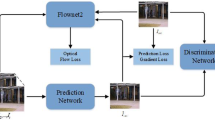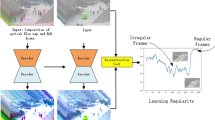Abstract
Video anomaly detection (VAD) aims to detect abnormal behaviors or events during video monitoring. Recent VAD methods use a proxy task that reconstructs the input video frames, quantifying the degree of anomaly by computing the reconstruction error. However, these methods do not consider the diversity of normal patterns and neglect the scale differences of the abnormal foreground image between different video frames. To address these issues, we propose an unsupervised video anomaly detection method termed enhanced memory adversarial network, which integrates a dilated convolution feature extraction encoder and a feature matching memory module. The dilated convolution feature extraction encoder extracts features at different scales by increasing the receptive field. The feature matching memory module stores multiple prototype features of normal video frames, ensuring that the query features are closer to the prototypes while maintaining a distinct separation between different prototypes. Our approach not only improves the prediction performance but also considers the diversity of normal patterns. At the same time, it reduces the representational capacity of the predictive networks while enhancing the model’s sensitivity to anomalies. Experiments on the UCSD Ped2 and CUHK Avenue dataset, comparing our method with existing unsupervised video anomaly detection methods, show that our proposed method is superior in the AUC metric, achieving an AUC of 96.3% on the UCSD Ped2 dataset, and an AUC of 86.5% on the CUHK Avenue dataset.
Access this chapter
Tax calculation will be finalised at checkout
Purchases are for personal use only
Similar content being viewed by others
References
Liu, W., Luo, W., Lian, D., Gao, S.: Future frame prediction for anomaly detection - a new baseline. In: Proceedings of the IEEE Conference on Computer Vision and Pattern Recognition, pp. 6536–6545 (2018)
Di Biase, G., Blum, H., Siegwart, R., Cadena, C.: Pixel-wise anomaly detection in complex driving scenes. In: Proceedings of the IEEE/CVF Conference on Computer Vision and Pattern Recognition, pp. 16918–16927 (2021)
Wang, Y., Peng, J., Zhang, J., Yi, R., Wang, Y., Wang, C.: Multimodal industrial anomaly detection via hybrid fusion. In: Proceedings of the IEEE/CVF Conference on Computer Vision and Pattern Recognition, pp. 8032–8041 (2023)
Xiang, T., et al.: SQUID: deep feature in-painting for unsupervised anomaly detection. In: Proceedings of the IEEE/CVF Conference on Computer Vision and Pattern Recognition, pp. 23890–23901 (2023)
Zhao, Y., Deng, B., Shen, C., Liu, Y., Lu, H., Hua, X.S.: Spatio-temporal autoencoder for video anomaly detection. In: Proceedings of the 25th ACM International Conference on Multimedia, pp. 1933–1941 (2017)
Nguyen, T.N., Meunier, J.: Anomaly detection in video sequence with appearance-motion correspondence. In: Proceedings of the IEEE/CVF International Conference on Computer Vision, pp. 1273–1283 (2019)
Zaheer, M.Z., Lee, J.H., Astrid, M., Lee, S.I.: Old is gold: redefining the adversarially learned one-class classifier training paradigm. In: Proceedings of the IEEE/CVF Conference on Computer Vision and Pattern Recognition, pp. 14183–14193 (2020)
Gong, D., et al.: Memorizing normality to detect anomaly: memory-augmented deep autoencoder for unsupervised anomaly detection. In: Proceedings of the IEEE/CVF International Conference on Computer Vision, pp. 1705–1714 (2019)
Park, H., Noh, J., Ham, B.: Learning memory-guided normality for anomaly detection. In: Proceedings of the IEEE/CVF Conference on Computer Vision and Pattern Recognition, pp. 14372–14381 (2020)
He, K., Fan, H., Wu, Y., Xie, S., Girshick, R.: Momentum contrast for unsupervised visual representation learning. In: Proceedings of the IEEE/CVF Conference on Computer Vision and Pattern Recognition, pp. 9729–9738 (2020)
Hui, T.W., Tang, X., Loy, C.C.: LiteFlowNet: a lightweight convolutional neural network for optical flow estimation. In: Proceedings of the IEEE Conference on Computer Vision and Pattern Recognition, pp. 8981–8989 (2018)
Isola, P., Zhu, J.Y., Zhou, T., Efros, A.A.: Image-to-image translation with conditional adversarial networks. In: Proceedings of the IEEE Conference on Computer Vision and Pattern Recognition, pp. 1125–1134 (2017)
Tang, Y., Zhao, L., Zhang, S., Gong, C., Li, G., Yang, J.: Integrating prediction and reconstruction for anomaly detection. Pattern Recogn. Lett. 129, 123–130 (2020)
Morais, R., Le, V., Tran, T., Saha, B., Mansour, M., Venkatesh, S.: Learning regularity in skeleton trajectories for anomaly detection in videos. In: Computer Vision and Pattern Recognition, pp. 11996–12004 (2019)
Fan, Y., Wen, G., Li, D., Qiu, S., Levine, M.D., Xiao, F.: Video anomaly detection and localization via Gaussian mixture fully convolutional variational autoencoder. Comput. Vis. Image Underst. 195, 102920 (2020)
Wu, P., Liu, J., Li, M., Sun, Y., Shen, F.: Fast sparse coding networks for anomaly detection in videos. Pattern Recogn. 107, 107515 (2020)
Zhou, J.T., Du, J., Zhu, H., Peng, X., Liu, Y., Goh, R.S.M.: Anomalynet: an anomaly detection network for video surveillance. IEEE Trans. Inf. Forensics Secur. 14(10), 2537–2550 (2019)
Hu, J., Zhu, E., Wang, S., Liu, X., Guo, X., Yin, J.: An efficient and robust unsupervised anomaly detection method using ensemble random projection in surveillance videos. Sensors 19(19), 4145 (2019)
Yang, Y., Zhan, D., Yang, F., Zhou, X.D., Yan, Y., Wang, Y.: Improving video anomaly detection performance with patch-level loss and segmentation map. In: 2020 IEEE 6th International Conference on Computer and Communications (ICCC), pp. 1832–1839 (2020)
Zhou, J.T., Zhang, L., Fang, Z., Du, J., Peng, X., Xiao, Y.: Attention-driven loss for anomaly detection in video surveillance. IEEE Trans. Circuits Syst. Video Technol. 30(12), 4639–4647 (2019)
Author information
Authors and Affiliations
Corresponding author
Editor information
Editors and Affiliations
Rights and permissions
Copyright information
© 2023 The Author(s), under exclusive license to Springer Nature Singapore Pte Ltd.
About this paper
Cite this paper
Liu, Y., Guo, Y., Du, K., Cao, L. (2023). Enhanced Memory Adversarial Network for Anomaly Detection. In: Jia, W., et al. Biometric Recognition. CCBR 2023. Lecture Notes in Computer Science, vol 14463. Springer, Singapore. https://doi.org/10.1007/978-981-99-8565-4_39
Download citation
DOI: https://doi.org/10.1007/978-981-99-8565-4_39
Published:
Publisher Name: Springer, Singapore
Print ISBN: 978-981-99-8564-7
Online ISBN: 978-981-99-8565-4
eBook Packages: Computer ScienceComputer Science (R0)




